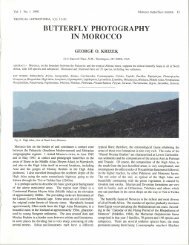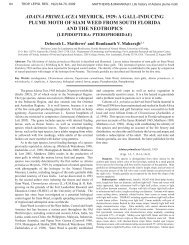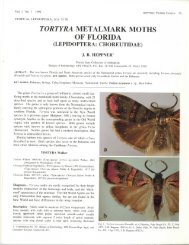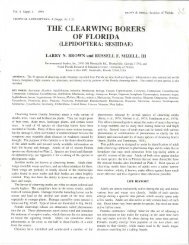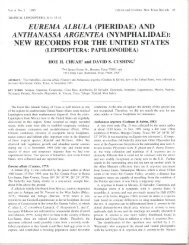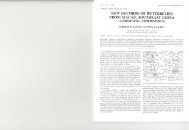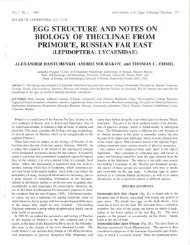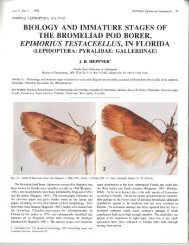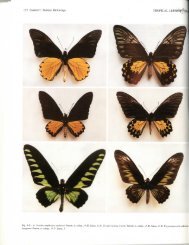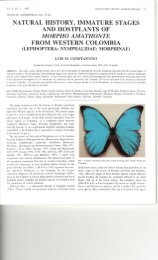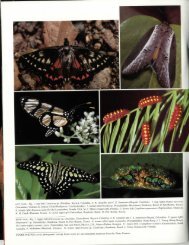intergeneric hybridisation between prepona and agrias
intergeneric hybridisation between prepona and agrias
intergeneric hybridisation between prepona and agrias
Create successful ePaper yourself
Turn your PDF publications into a flip-book with our unique Google optimized e-Paper software.
FURTADO: Hybridism <strong>between</strong> Prepona <strong>and</strong> Agrias TROPICAL LEPIDOPTERA, 18(1): 5-6, 2008 5INTERGENERIC HYBRIDISATION BETWEENPREPONA AND AGRIAS(LEPIDOPTERA: NYMPHALIDAE, CHARAXINAE)Eurides FurtadoCaixa Postal 97, 78400-000 Diamantino, Mato Grosso, BRAZILAbstract – A hybrid was obtained, crossing by h<strong>and</strong>‐pairing, the male of Prepona omphale rhenea Fruhstorfer = Prepona rothschildi cuyabensis Le Moult with the femaleof Agrias claudina godmani Fruhs torfer. The larvae were fed on Hirtella gracilipes (Hook. f.) (Chrysobalana ceae), the natural host plant for the female.r e s u m o.– Obteve‐se um híbrido intergenérico, cruz<strong>and</strong>o‐se pelo método h<strong>and</strong>‐pairing, o macho de Prepona omphale rhenea Fruhstorfer = Prepona rothschildi cuyabensisLe Moult com a fêmea de Agrias claudina godmani Fruhstorfer. As larvas foram alimentadas com Hirtella gracilipes (Hook. f.) (Chrys obalanace ae), a planta hospedeiranatural da fêmea.Key words: Brazil, Chrysobalanaceae, genetics, h<strong>and</strong>-pairing, hostplants, hybridization, Mato Grosso, Neotropical, South America.__________________________________Natural hybrids are rare, even among very common species. Theonly known hybrid from natural <strong>intergeneric</strong> crossing, <strong>between</strong>Prepona <strong>and</strong> Agrias, was collected at Huallaga River, Huanuco,Peru, <strong>and</strong> is entrusted to the Mays Collection, Malibu, California,USA. It is a beautiful male sample (Fig. 3), presenting the commoncharacteristics of both genus: the dorsal surface coloration resembleAgrias claudina lugens Staudinger, the ventral surface has his color<strong>and</strong> drawings mixed, showing characteristics of the last species,<strong>and</strong> quite probably similar to Prepona praeneste Hewitson (Mays,pers. comm.; Barselou, 1983).By rearing in the laboratory two of the more common speciesof Agrias <strong>and</strong> several of Prepona, observing their habits <strong>and</strong> thesimilarities <strong>between</strong> their immature stages, I was convinced thatthey are congeneric (Furtado, 1984). Later, this conviction wasreinforced by a fortuitous collection of one adult larva of Preponapherida mas (Cramer) feeding on Hirtella gracilipes (Hook. f.)(Chryso bala nace ae), the same natural host plant used in MatoGrosso by Agrias claudina godmani Fruhstorfer (Furtado, pers.obs.; Casagr<strong>and</strong>e <strong>and</strong> Mielke, 1997). Coincidence of hostplantproved the possibility of obtaining a hybrid.In this research, accomplished during the period October-Desember 1994, a female of Agrias claudina godmani Fruhstorfer(Fig. 1) was crossed with Prepona omphale rhenea Fruhstorfer,the priority name for Prepona rothschildi cuyabensis Le Moult(Fig. 2). The studied material comes from high Arinos River,Diamantino, Mato Grosso, Brazil.MATERIAL AND METHODSFemales were bred in captivity, in a nursery made from plasticnetting built with boughs of the hostplant, Hirtella gracilipes. Themale Prepona specimens were captured in the wild.With several virgin females of Agrias claudina godmaniavailable, I initially tried (but was not successful) to collect malesof Prepona pheridamas in the wild. In those collecting trips I gotseveral males of Prepona dexamenes Hopffer, Prepona eugenesBates <strong>and</strong> Prepona omphale rhenea, <strong>and</strong> all of them were easilyh<strong>and</strong>‐paired with A. claudina godmani.RESULTSThe female Agrias claudina godmani that crossed with Preponaeugenes was destroyed by ants before having laid eggs. The layingof the female crossed with P. dexamenes was fertile, but all itslarvae died during the second instar, which probably was caused byincompatibility with the host plant. The crossing with P. omphalerhenea, resulted in normal larvae, that fed on H. gracilipes,completed the life cycle in 68 days, a short time, if compared withthe one of P. omphale octavia Fruhstorfer at 97 days (Muyshondt,1973) <strong>and</strong> the one of A. claudina claudian us Staudinger at 93 days(Casagr<strong>and</strong>e <strong>and</strong> Mielke, 1985).Agrias claudina godmani femaleXPrepona omphale rhenea maleThe larva of the fifth instar (Fig. 4) resembles Prepona, especiallydue the ochreous color <strong>and</strong> the latero‐dorsal blu ish‐gray spots. Theoblique b<strong>and</strong>s are stronger than these as of the larvae of Agrias.The other characteristics are similar to that of the parental species,whose larvae are very similar, except for the ventral coloration,which is dark brown in A. claudina <strong>and</strong> ochreous in P. omphale.All of the hybrids obtained (Fig. 5‐8) were males <strong>and</strong> smallerthan their parents, with wing length: 60‐68mm. The morphologyof the wings resembles that of Prepona. The wings coloration <strong>and</strong>patterns are mixed. The characteristic red color found in the female,is becomes lighter or turns orange in some offspring specimens. Inthe dorsal surface of the forewing, reddish color is predominant, asin A. claudina, with a small portion of the blue b<strong>and</strong> of Prepona,in the inner margin. The blue discal area with the submarginalsmall ocelli remind of the characteristics of the male, but in somespecimens, reddish spots characteristic of females appear in thispart of the wing. The coloration <strong>and</strong> patterns of the ventral surfaceis intermediate (Fig. 8).ACKNOWLEDGMENTSTo Dr. Olaf H. H. Mielke, of the Department of Zoology ofUniversidade Federal do Paraná, <strong>and</strong> to Prof. Gert Hatschbach, ofMuseu Botânico Municipal, both from Curitiba, Paraná, Brazil, forthe identifica tion of the hostplant; to Phillip Mays, from Malibu,California, USA, for the informations <strong>and</strong> pictures of specimensfrom his collection; to Dr. Everardo José Grossi <strong>and</strong> Mrs. ReginaRajs, both from Nova Friburgo, Brazil, for the translation <strong>and</strong> therevision of the manuscript into English language.REFERENCES CITEDBarcelou, P. E.1983. The genus Agrias. Compièg ne: Sciecnes Nat. 96pp. 15 pls.Casagr<strong>and</strong>e, M. M. & O. H. H. Mielke1985. Estágios imaturos de Agrias claudina claud ianus Staudinger (Lepidoptera,Nymphalidae, Charaxinae). Revta. Bras. Ent. (São Paulo), 29:139‐142.1997. Plantas hospedeiras das espécies de Agrias Doubleday. (Lepidop tera,Nymphalidae, Charaxinae). Revta. Bras. Zool. (Curitiba), 14: 771‐772.Furtado, E.1984. Contribuição ao conhecimento dos Lepidoptera brasileiros. I. Biologiade Agrias amydon ferdin<strong>and</strong>i Fruhstorfer (Nymph alidae, Charaxi nae).Revta. Bras. Ent. (São Paulo), 28:289‐294.Muyshondt, A.1973. Notes on the cycle <strong>and</strong> natural history of butterflies of El Salva dor. I.Prepona omphale octavia (Nymphalidae). J. Lepid. Soc. (Los Angeles),27:210‐219.
6 FURTADO: Hybridism <strong>between</strong> Prepona <strong>and</strong> Agrias TROPICAL LEPIDOPTERA, 18(1):5-6, 2008FIGURESFig. 1. Agrias claudina godmani, female, dorsal <strong>and</strong> ventral views. Fig. 2. Prepona omphale rhenea, male, dorsal <strong>and</strong> ventral views. Fig. 3. Natural hybrid <strong>between</strong>Prepona <strong>and</strong> Agrias, dorsal <strong>and</strong> ventral views. Fig. 4‐8. Hybrids <strong>between</strong> Agrias claudina godmani female <strong>and</strong> Prepona omphale rhenea male: 4) larva of fifth instar,latero‐dorsal view; 5‐8) adults males (5‐7 dorsal views); 8) ventral view.



